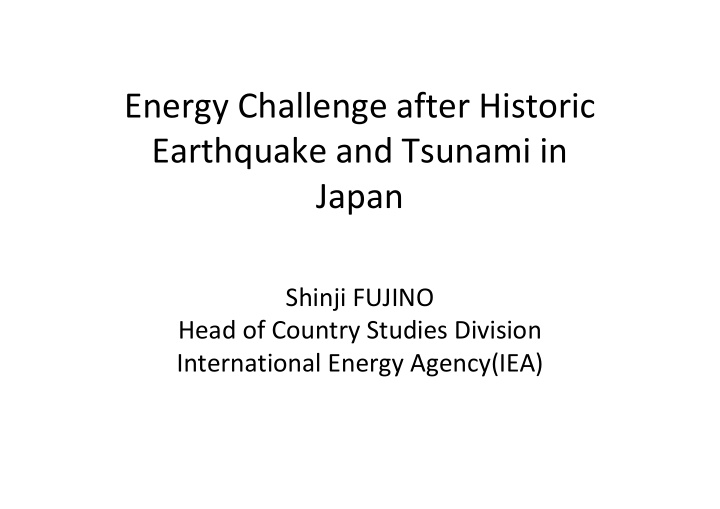



Energy Challenge after Historic Earthquake and Tsunami in Japan Shinji FUJINO Head of Country Studies Division International Energy Agency(IEA)
Japan Faces an Unprecedented Challenge Japan Faces an Unprecedented Challenge Tsunamis 14 meters or higher Earthquakes: M - 9.0 quake (March 11) M - 7 class 5 times M - 6 class 63 times M - 5 class 335 times Faces TOKYO ■ ■ ■ ■ Fukushima Dai-ichi
4 Nuclear Power Stations with 14 Units Nuclear Reactors near Epicenter of the Earthquake automatic cold shut down shut down Onagawa Unit 1 524 MW, 1984- Unit 2 825 MW, 1995- Unit 3 825 MW, 2002- Fukushima Dai-ichi Unit 1 460 MW, 1971- Unit 2 784 MW, 1974- Unit 3 784 MW, 1976- Unit 4 784 MW, 1978- Unit 5 784 MW, 1978- Unit 6 1,100 MW, 1979- Periodical Fukushima Dai-ni inspection Unit 1 1,100 MW, 1982- Unit 2 1,100 MW, 1984- Unit 3 1,100 MW, 1985- Unit 4 1,100 MW, 1987- Tokai Dai-ni Unit 1 1,100 MW, 1978-
Fukushima Dai-ichi Nuclear Power Station Cause of the Damage Grid Line ① Loss of Off-site Power ① ① ① due to the Earthquake Reactor Building About About Turbine Tsunami (estimated 14m) 40M 20M Building ② ② Diesel Generator Inoperable ② ② Diesel Generator 5.4 ~5.7m Elevation: about 10m due to the Tsunami Seawater level All Motion Operated Pumps including ECCS became Inoperable Seawater Pump
LOST GENERATION 14 March 2011 Thermal Nuclear Total (in MW) LNG Oil Coal Total TEPCO 6 428 1 000 5 150 1 000 7 150 13 578 JAPC 1 100 - - - - 1 100 Tohoku – 2 174 446 850 1 000 2 296 4 470 EPCO Total 9 702 1 446 6 000 2 000 9 446 19 148 (9.7GW) (9.4GW) (19.1GW)
Power Generation and Transmission � ��������������
Transmission Interconnectors � ��������������
Impact on Energy Supply/Demand in Japan Impact on Energy Supply/Demand in Japan
Power Supply/Demand Plan Announced by Government of Japan (8 April) • Measures to respond to power shortage in this summer - Estimated peak demand in TEPCO region 55GW - Available supply capacity by TEPCO 45GW
Demand Side Measures Peak demand cut: 10GW in TEPCO region Large consumers (> 500kW): 25% (mandatory) • Further improving efficiency in manufacturing process • Installing more energy efficient machines/equipments • Shifting/shortening working time • Shifting/extending summer holidays etc
Smaller Businesses (< 500kW): 20% (voluntary measures) • Decreasing cooling • Reducing lighting • Reducing IT equipment • Temperature appropriate clothing etc Households: 15 – 20 % (Voluntary measures) • Decreasing cooling • Reducing stand-by power • Reducing lighting • Installing more efficient appliances etc
Supply Side Measures By summer 2011 • Additional capacity: 5GW in TEPCO region After summer 2011 • Continue to restore damaged thermal capacities • Additional new thermal capacities • Accelerate existing plans • Smaller size gas turbines • Strengthen interregional connections • Renewable power capacity • Low carbon technology R&D etc.
25 Energy Efficiency Recommendations How did implementation compare across member countries in 2009 ? � ��������������
Energy Intensity in Japan and in Other Selected IEA Member Countries toe per thousand USD of GDP at 2000 prices and purchase power parities 0.45 Australia Canada 0.4 France Germany 0.35 Italy Japan 0.3 United Kingdom 0.25 United States IEA Total 0.2 0.15 0.1 0.05 0 1973 1978 1983 1988 1993 1998 2003 2008 � ��������������
Energy Supply and Electricity Generation, 2009 Other Other renewable renewable Hydro Hydro 3% 2% 1% 7% Coal Nuclear Coal 22% 15% 27% Nuclear Gas 27% 17% Oil 9% Oil Gas 43% 27% Total Primary Energy Supply Total Electricity Generation 472 Mtoe 1041 TWh � ��������������
IEA Member Countries’ LNG Imports � ��������������
LNG Imports by Japan 2000 2010 Source: IEA � In 2000, LNG imported from 8 countries but now from 15 countries-twice as diversified in search for better deals � New Exporters: Russia, Nigeria, Egypt… � ��������������
Renewable Energy Percentage of Total Primary Energy Supply, 2009 50% Biofuels and waste 40% Solar Geothermal 30% Wind 20% Hydro 10% 0% � ��������������
Energy Plan of Japan Energy Security • Double energy self-sufficiency ratio by 2030 (18% in 2009) Environmental sustainability • CO2 emission reduction: 25% below 1990 levels by 2020 • Zero emission power generation (nuclear and renewables): 50% by 2020, 70% by 2030 (34% in 2009) - Nuclear: 9 additional units by 2020 14 additional units by 2030 - Renewables: 10% TPES by 2020 (3.5% in 2009)
Information Dissemination by Government of Japan Tourism • 1. http://www.mlit.go.jp/kankocho/en/index.html
Recommend
More recommend